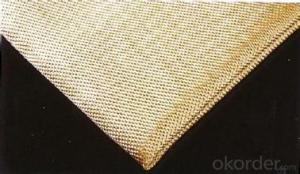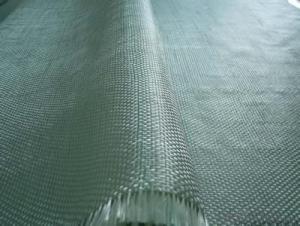vermiculite coated fiberglass cloth high quality
- Loading Port:
- Shanghai
- Payment Terms:
- TT OR LC
- Min Order Qty:
- 10000 m²
- Supply Capability:
- 500000 m²/month
OKorder Service Pledge
OKorder Financial Service
You Might Also Like
vermiculite coated fiberglass cloth
Well-distributed, even tensile strength, good vertical performance.
Fast impregnation, good moulding property, easily removing air bubbles.
woven roving 800g /m2 non-alkali .
Products Introduction and Application
E-Glass woven roving is plain, biaxial fiberglass fabric that weaved with E-Glass direct roving. E-Glass Woven roving is compatible with unsaturated polyester, vinyl ester, epoxy and phenolic resins. It’s widely used in hand lay up, mold press, GRP forming process and robot processes to manufacture boats, vessels, plane, automobile parts, panels, storage tanks etc.
Products Features and Advantages
Well-distributed, even tensile strength, good vertical performance.
Fast impregnation, good moulding property, easily removing air bubbles.
High mechanical strength, less strength loss in wet condition.
Key Technical Data
Specs | Unit Mass (g/m2) | Breaking Strength≥N/2.5cm | Density | Weave | Roll Length (m) | Width (mm) | |||
Warp | Weft | Warp | Weft | ||||||
EWR400 | 400 | 1480 | 1380 | 3.5 | 3.3 | plain | 100-200 | 300-4000 | |
EWR600 | 600 | 1900 | 1800 | 3.0 | 2.5 | plain | 100-200 | 300-4000 | |
EWR800 | 800 | 2600 | 2350 | 2.0 | 2.0 | plain | 100-200 | 300-4000 | |
Packing Style
It is rolled on a paper core with a diameter of 100mm, then packed into a polyethylene bag, then outside packed into a separate cardboard box. Finally, the product can be ether shipped with cardboard box only or with pallet.
Storage
In dry and cool places. The best condition is with temperature between 15°C and 35°C, with a relative humidity between 30% -70%. Before use, please keep it in original package.
fibreglass Sample is free,freight is collect
- Q:What color steel plate is good for dust-free workshop?
- EPS polystyrene foam sandwich panel is composed of a color plate surface, closed self extinguishing type polystyrene foam plastic as the core material, the color pressure plate by automatic continuous molding machine with high strength after adhesive bonding and into an efficient new composite materials. Mainly used in public buildings, industrial buildings roofing, walls and electronics, medicine, food and clean workshop and the combination of cold storage, building add layer, Shangting etc. The utility model has the advantages of light weight, convenient installation, heat preservation, heat insulation, waterproof, etc., and has the characteristics of fast construction, long service life, beautiful appearance, high mechanical strength of steel materials, easy molding performance, etc..
- Q:What are the different weaves available for fiberglass fabric?
- Fiberglass fabric offers a variety of weaves, each with distinct qualities and applications. Among the most commonly used weaves are plain, twill, satin, and leno. The plain weave stands as the simplest and most prevalent option for fiberglass fabric. It consists of an equal number of warp and weft yarns crossing over and under each other in a straightforward pattern. This weave produces a durable and balanced fabric with excellent stability. Twill weave, another popular choice, involves the diagonal crossing of warp and weft yarns, resulting in a noticeable ribbing effect. Compared to plain weave, twill offers enhanced drapability and flexibility, making it ideal for applications requiring greater conformability. Satin weave is a more intricate option, yielding a smooth and lustrous fabric surface. It features long floats of either warp or weft yarns, resulting in fewer interlaced yarns and a lightweight, supple fabric. Satin weave finds its place in applications desiring a high-quality appearance and soft texture, such as clothing and decorative fabrics. Leno weave stands out as a unique option, involving the twisting of adjacent warp yarns to create an open mesh structure. This weave is commonly employed for fiberglass fabrics that require transparency, breathability, filtration, or reinforcement. Ultimately, the choice of weave for fiberglass fabric depends on the specific needs of the application. By considering factors like strength, flexibility, appearance, and breathability, one can select the most suitable weave to achieve optimal performance for their desired purpose.
- Q:How is fiberglass fabric used in the production of fireproof curtains?
- Fiberglass fabric is used in the production of fireproof curtains due to its excellent fire-resistant properties. The fabric is woven from fine strands of glass, which can withstand high temperatures and prevent the spread of fire. By incorporating fiberglass fabric into the curtains, they become highly resistant to flames and can effectively block the passage of heat and smoke, providing an added layer of safety and protection in fire-prone areas.
- Q:Can fiberglass fabric be used for making flags and banners?
- Yes, fiberglass fabric can be used for making flags and banners. It is a durable and lightweight material that can withstand outdoor conditions. It is also resistant to tearing and fading, making it a suitable choice for long-lasting flags and banners.
- Q:How does fiberglass fabric perform in cryogenic temperatures?
- Fiberglass fabric performs well in cryogenic temperatures as it has excellent thermal insulation properties and maintains its structural integrity even at extremely low temperatures. It is highly resistant to thermal shock and can withstand prolonged exposure to cryogenic environments without significant degradation.
- Q:What cloth is used for the anticorrosion of fire pipes?
- Use glass fiber cloth, three oil, two cloth, anticorrosive.
- Q:Large screen whole electric lift screen, PVC good or glass fiber?
- If the effect of a long decline, it depends on how long the time is really down, both can not escape the fate of decline.
- Q:Glass fiber cloth and glass fiber?
- As reinforcing materials, glass fibers have the following characteristics, which make fiberglass far more widely used than other kinds of fibers and develop far ahead of their characteristics:(1) high tensile strength and small elongation (3%).(2) high elasticity and good rigidity.(3) the elongation within the elastic limit is large and the tensile strength is high, so the impact energy is large.(4) for inorganic fiber, with non flammable, chemical resistance.(5) water absorption is small.(6) the scale stability and heat resistance are excellent.(7) good processability, can be used as stock, bundle, felt, weaving and other forms of products.(8) transparent and permeable to light(9) the development of surface treatment agents with good resin properties.(10) the price is cheap.
- Q:Is fiberglass fabric resistant to UV degradation in outdoor applications?
- Yes, fiberglass fabric is highly resistant to UV degradation in outdoor applications. Fiberglass fabric is made from fibers that are manufactured to withstand prolonged exposure to sunlight and other environmental factors. The fabric is treated with special coatings or finishes that provide additional protection against UV radiation. This UV resistance makes fiberglass fabric an ideal choice for outdoor applications where exposure to sunlight is a concern, such as in awnings, canopies, and outdoor furniture. Additionally, fiberglass fabric maintains its strength and integrity even after years of exposure to UV rays, ensuring its long-lasting performance in outdoor settings.
- Q:Is fiberglass fabric easy to cut and sew?
- Yes, fiberglass fabric is relatively easy to cut and sew. It can be cut using standard fabric scissors or a sharp utility knife. However, it is important to note that fiberglass fabric can be more difficult to cut than traditional fabric materials due to its strength and durability. It is recommended to use sharp tools and apply steady pressure to ensure clean cuts. When it comes to sewing, fiberglass fabric can be sewn using a regular sewing machine or by hand. It is recommended to use a heavy-duty needle and a strong, durable thread such as polyester or nylon. Additionally, it may be helpful to use a walking foot attachment on the sewing machine to handle the thickness and stiffness of the fabric. Overall, while fiberglass fabric may require slightly more effort and specialized tools compared to traditional fabrics, it is still possible to cut and sew it with relative ease. With proper tools, techniques, and precautions, you can successfully work with fiberglass fabric for various projects.
1. Manufacturer Overview |
|
|---|---|
| Location | |
| Year Established | |
| Annual Output Value | |
| Main Markets | |
| Company Certifications | |
2. Manufacturer Certificates |
|
|---|---|
| a) Certification Name | |
| Range | |
| Reference | |
| Validity Period | |
3. Manufacturer Capability |
|
|---|---|
| a)Trade Capacity | |
| Nearest Port | |
| Export Percentage | |
| No.of Employees in Trade Department | |
| Language Spoken: | |
| b)Factory Information | |
| Factory Size: | |
| No. of Production Lines | |
| Contract Manufacturing | |
| Product Price Range | |
Send your message to us
vermiculite coated fiberglass cloth high quality
- Loading Port:
- Shanghai
- Payment Terms:
- TT OR LC
- Min Order Qty:
- 10000 m²
- Supply Capability:
- 500000 m²/month
OKorder Service Pledge
OKorder Financial Service
Similar products
New products
Hot products
Hot Searches
Related keywords




























